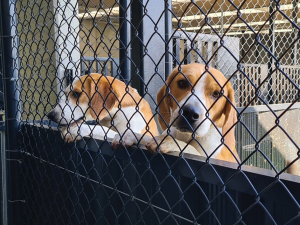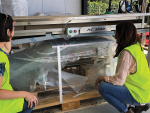A behind-the-scenes look at Auckland International Airport's biosecurity arrangements provided the team at New Zealand Winegrowers with some interesting insights into the lives of detector dogs, the eating habits of long-haul passengers... and dirty laundry.
New Zealand Winegrowers (NZW) and the Ministry for Primary Industries (MPI) work together through the Government Industry Agreement (GIA) on many biosecurity readiness projects. We recently had an opportunit to find out more about how biosecurity is managed at the airport, thanks to Fin Lambermon, GIA Partnership Readiness and Response Services, who arranged a tour of the MPI detector dog programme premises and a sneak peek behind the scenes at the Auckland Airport biosecurit-controlled area.
At the dog facility, the manager of the detector dog programme was our guide and he happened to train NZW Biosecurity Manager Sophie Badlnd back in her day as a dog handler. There are 30-40 dogs housed at the detector dog facilities, including labradors, pointers, an English springer spaniel, and many beagle harrier dogs. The beagle harrier is taller than a standard beagle and originates from France. Being a hound dog, it is very suited to scent work. Some of the dogs are trained for specific tasks, such as Yamba who can detect the brown marmorated stink bug.
The facilities include an operational room, laundry, and a food preparation area with at least eight different food bins. The areas are impeccably well kept, clean and tidy. During the day, dogs that are not working are all outdoors in beautiful, grassed areas, with toys, water and shade cloth. Dogs are brought in at night to their kennels inside a large building.
At 7 years of age, detector dogs are given six monthly health checks to ensure they have no long-term injuries so they can continue to work. Some dogs retire to retirement homes at 8 years old, while others continue to work if healthy. Although there is no in-house vet, a veterinarian visits regularly; there is a consultation room on site not dissimilar to one you would find at your local vet clinic except they also have dedicated physio equipment for balance and strengthening of the dogs. There's also an outdoor swimming pool for the rehabilitation of injured dogs, which is used by Customs and Police dogs too.
Dogs commence their training at 12-14 months of age and are working by 2 years old. Detector dog teams work in rotational shifts at all international ports of entry, such as airports, ports, the International Mail Centre in Auckland, international cargo companies, and cruise ships arriving from overseas. At border control at Auckland Airport the dogs are worked for 20 minutes and then rested for a short time before another 20-minute round. Dogs are trained to find biosecurity risk items (especially plants and animals, and plant and animal products) which could be carrying pests or diseases.
The dogs learn to respond in a passive manner by sitting next to the baggage containing any known risk items and holding their nose on the source of the odour. The dogs are then rewarded with food for correct responses. We witnessed exactly this when we watched two new handlers and their dogs go through their paces in the training hall.
Over at Auckland Airport we were guided by the Operations Manager for Auckland Airport Biosecurity. Our arrival coincided with peak time for border control, with a few hundred passengers waiting to be processed through the border check, and an Emirates A380 about to land with another 400 passengers. It was great to see a detector dog and handler monitoring the 'nothing to declare' line, ensuring all passengers were subject to at least one biosecurity check before leaving the arrivals area.
The biosecurity controlled area includes a lab (where biosecurity risk items are inspected, cleaned or held for further treatment); a risk assessment area (where passengers are questioned about their declarations and directed for further intervention); the search bench (where luggage is searched and risk items are checked), and the x-ray area. Unfortunately, a new state of the art carry-on baggage scanner, the 920CT, was damaged during the Auckland floods and it is yet to be fixed.
Apparently the early morning flights from North America and Asia are prone to bringing in food due to the 12-hour flight duration. Australian travelers, given the short distance, are less likely to bring anything that poses a biosecurity risk. Australia also has very similar biosecurity rules to New Zealand and travelers generally are aware of the requirements. However, we did find out about a Waikato dairy farmer who came off a plane in the clothes he had been wearing at a farm in Indonesia, where foot and mouth disease outbreaks are spreading. His clothes and boots were confiscated at the border, but no he didn't go home naked - border employees bought him new clothes to wear and the confiscated clothes were washed and returned to him after being washed and disinfected.
Paper arrival cards are still marked and counted manually; however, this is set to change within the next year when electronic passenger arrival cards will be introduced.
While the MPI team does a great job at the border, it's important to remember that biosecurity is everyone's responsibility. If you see something unusual, remember to Catch It, Snap It and Report It to the Biosecurity NZ hotline on 0800 80 99 66, and get in touch with the NZW biosecurity team at This email address is being protected from spambots. You need JavaScript enabled to view it..














